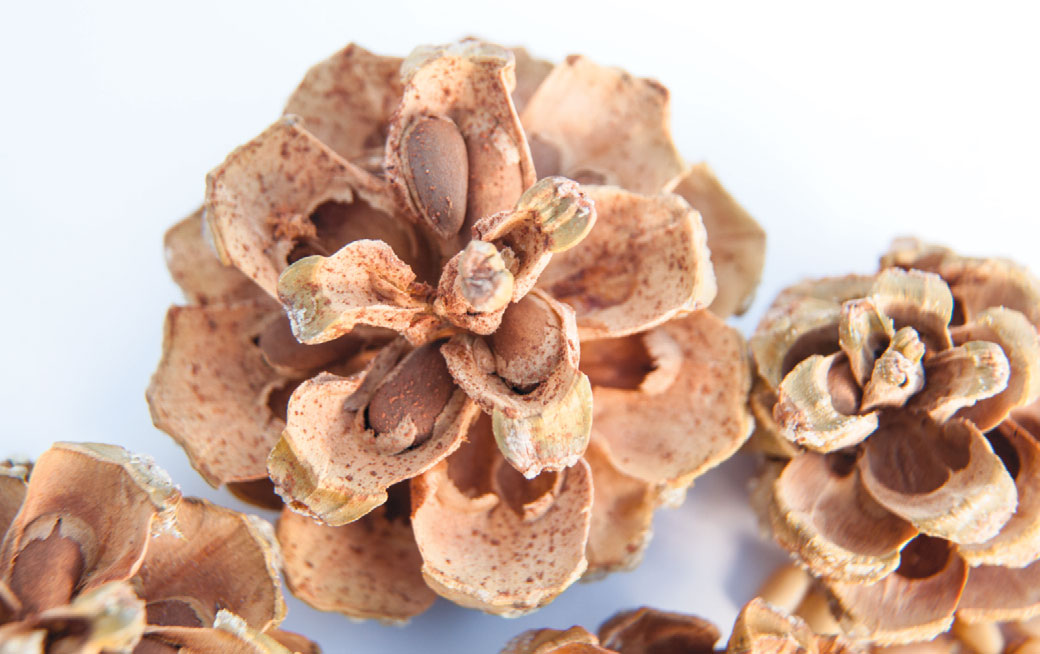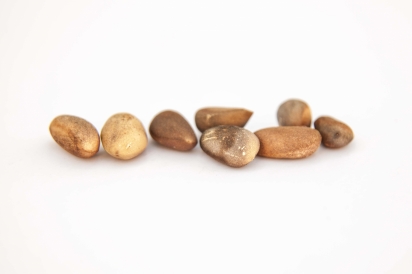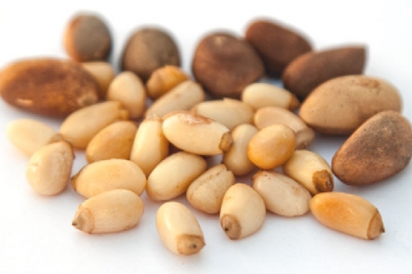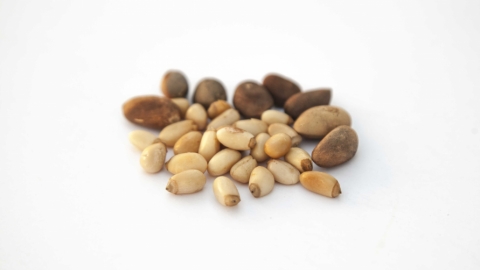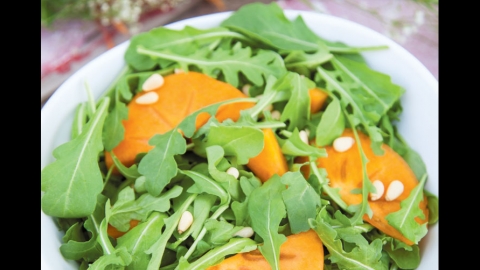Local Gold: Prospecting for Pine Nuts
I love pine nuts—those sweet, tender kernels of buttery delight, a delicious gift of the high desert piñon juniper forests (or, as locals call it, the PJ).
When I first moved to an elevation of 4,500 feet, below the Mogollon Rim, I was excited to find piñon trees all around my house. But this year there are few cones, and the nuts inside every one are hollow. No pine nuts! Being a wild food, the pine nut is unpredictable. Lean years are normal. In fact, a good piñon harvest occurs only about every four years. An abundant harvest occurs only about every seven years. Individual trees mature around 30 years, do not bear annually and the crop area shifts across the landscape each year depending on local climate conditions.
I called my Navajo friend and asked if she had harvested any this fall and she said yes, up towards Ganado. Also, there are people harvesting around Grand Canyon, maybe Cameron.
“How do you know where to go?” I asked.
“You have to look around,” she answered. Like panning for gold, it takes time.
Foragers who know their territory look for areas with productive trees since the cones take three seasons to mature. People know where the harvest was best the last few years, so they have a good idea in advance where to gather.
When the cones ripen in August, word spreads on where to go for the harvest. One can see trucks along roadsides and groups of people harvesting wherever the crop is good in the forested areas in northern Arizona, usually around 5,000 to 7,000 feet elevation. For Natives, it is traditionally a family outing, a happy gathering of all generations.
According to my friends and online sources, there are several methods traditionally used by Native people for the harvest.
The Owens Valley Paiute way to harvest is to beat the green cones off the tree with a pole, and store them in bags in the sun until the cones open and release the nuts. They then beat the bags of cones to loosen the nuts. By this method all the nuts are in the bag, but may still need to be removed from the sticky pitch-covered cones.
The Navajo way is to wait for the nuts to fall from the open cones, then gather them by hand before the ground squirrels, pack rats and insects get them. Some use tarps or spread blankets under the trees to catch the nuts. It is said that beating the cones off the tree will hasten the winter and shorten the harvest season.
Another method used by Afghans and Pakistanis involves raking the unopened cones into pile and igniting them. The pitch burns off, the cones open and the nuts are released, already toasted.
By any account, the harvest is time-consuming and labor-intensive, as well as dirty work; one’s hands become covered with sticky pitch. And when the harvest is over, after a day or two, there is still one more step: removing the pine nuts from the shell.
No wonder the price of shelled nuts approximates that of a precious metal.
There are many varieties of pine trees around the world that bear edible nuts. They are relished in the cuisines of the Mediterranean, Asia, Russia, Pakistan, South Africa, Central America and Mexico.
Here in the Southwest there are two types. The Pinus edulis, or the Colorado piñon, is common in Arizona, New Mexico, Utah and Colorado. Pinus monophyillia, or single-leaf piñon, is predominant in California and Nevada. It is often referred to as the Nevada piñon.
The Colorado piñon is hard-shelled, smaller and has more protein and fat than the soft-shelled Nevada piñon. The Nevada piñon is almost twice as large (up to an inch in length), opens with finger pressure and has more carbohydrates, less fat and protein.
A special feature of the piñon tree is its symbiotic relationship with Piñon jays (sometimes spelled Pinyon jays). Having evolved over the millennia, the trees offer shelter and nutritious seeds, while the resourceful birds, which know to bury the surplus for lean years, help regenerate and spread the piñon forests.
The Piñon jays form colonies of about 250 birds, congregating where the pines are currently producing. They nest in ponderosa, juniper and oak as well as piñon, and roost in the trees to collect the nuts, their cawing echoing across the landscape. In this way they are good indicators of seasonally productive groves of pine. Researchers have discovered that each bird can harvest thousands of seeds annually. They remember 95% of their caches, so 5% of the seeds remain buried in open grassy areas to grow into new trees.
The archaeological record reveals that ancestral Native people would roast and store nuts in clay pots buried underground. Today there are alternative containers for storage, but it is generally best to store raw, shelled nuts in the refrigerator or freezer. Toasted nuts with shells on can keep in a loosely covered container in a cool, dry place for months, but need to be eaten within a few days after shelling if not refrigerated. Commercial shelled nuts are often pasteurized to preserve them and protect them from pathogens.
New Mexico is famous for its piñon nut harvest. The winter air in communities there is fragrant with the scent of burning piñon wood, reminiscent of incense. In the earlier decades of the last century, the Navajo would harvest thousands of pounds of nuts and sell them to companies that shipped them by train to the East Coast. In his book Desert Terroir, Gary Paul Nabhan, ethno-botanist and local foods champion, tells of his Middle Eastern ancestors roasting New Mexico pine nuts to sell on the streets of their new home in Brooklyn, New York, in the 1940s. The sweet, rich nuts may have soothed homesickness for the Old Country.
Although the last two years have yielded bumper crops in New Mexico, such harvests may become more rare for a number of reasons. Climate change has caused warmer temperatures and less rainfall, resulting in fewer cones and empty shells. Piñon forests have been cleared in recent decades for cattle grazing because land managers deemed the trees economically worthless.
Today, in the Southwest the PJ forests have been attacked by bark beetle and devastated by wildfires, resulting in a loss of habitat, and loss of a major food source for the jays. With fewer birds, the forests will be further diminished.
“Pinyon Penny” Frazier, an expert on the trees and champion of piñon juniper landscape conservation, describes how the piñon woodlands could yield hundreds of dollars per acre from a good nut harvest, instead of the $1.17 per year earned from cattle leases. She advocates for piñon harvests as a means of stewardship and an economic resource for rural communities. It seems like an excellent plan, but large commercial harvesting of wild foods is difficult and labor intensive, and production is erratic.
Once pesto became popular in the 1970s, people discovered the culinary versatility of the pine nut. Demand in the U.S. has grown in recent decades and imports have soared. Today, most nuts consumed by Americans come from China and Russia. Other sources include South Africa and South Korea. In 2014 the U.S. imported more than 3,000 metric tons of shelled pine nuts from China alone. By one estimate the total value of nuts imported was $70 million.
The scale of imports suggests the important economic and food value of our wild and fragile Southwest landscapes. In an age of potential food insecurity let’s nurture our piñon forests and protect the rich bounty they provide to both man and animal. Let’s continue to relish the delicious wild Southwestern pine nuts. Like precious metals, and all good foods, they are worth the care and labor.
Cooking with Pine Nuts
Pine nuts add their magic to almost any dish, from pesto to pilafs, fillings, salads, cookies, candies, cakes and tarts. They can be used raw or toasted.
Sources
There are many sources for pine nuts online. Here are a few suggestions for genuine Southwestern pine nuts:


